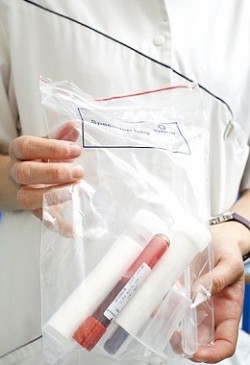In the procedure of general blood testing (this is exactly how scientifically called «leaf with analyzes») there is nothing complicated.
Why it is necessary

For what we We rent blood? The doctor must assess the state of our body in the case when we appeal to health complaints. And makes a specialist this assessment based on hemoglobin content in red blood cells, erythrocyte sedimentation rate, leukocyte formula. To make the final verdict, the doctor compares the results obtained with the rate indicators - characteristic «Healthy» blood. Inconsistencies associated with increasing the percentage of any type of blood cells, talk about states whose names are formed by adding endings «-and I», «-Oz» or «-Yez», To the name of the corresponding cell form. For example, neutrophilez, eosinophilia, red blood cell. The decrease in the percentage indicators of the cells is indicated by adding to their expiration names «-singing» - Neutropenia, eosinopenia.
How to prepare for blood take
Our site will remind you to what you need to pay attention to the results of the analyzes to be as accurate as possible. Blood from the finger is given on an empty stomach in the morning - this means that after the last meal, the food must pass about 10 hours. Before going to the clinic, you can drink some water (tea, coffee, dairy products - taboo). If you used alcoholic beverages on the eve, it is better to forget about the visit of the laboratory for a few days. In addition, a day before the procedure should not be engaged in intense exercise, go to the bath.
What are the numbers say

Erythrocyte sedimentation rate (EE) - A healthy person is normal in the normal range of 1-10 mm / hour (men) and 2-15 mm / hour (women). It should be borne in mind that the SE indicators may vary under the influence of a number of physiological reasons (food intake - up to 25 mm / hour, menstruation or pregnancy - up to 45 mm / hour). From the increase of ESP, nothing good to wait, it says about the presence of an inflammatory process in the body. It can be:
- Infectious inflammatory diseases (pneumonia, sepsis, myocardial infarction, tuberculosis, syphilis);
- inflammatory processes due to injuries and bone fractures;
- Operational interventions.
In addition, the increase in ESP can also be caused by both inflammatory states:
- liver diseases;
- kidney disease;
- diabetes, thyrotoxicosis;
- pregnancy, postpartum, menstruation;
- poisoning by chemicals (for example, arsenic);
- anemia.
Reduced ESO is observed at:
- Eritremia (benign blood illness);
- increasing the level of bile acids;
- hyperbirubinemia;
- chronic blood circulation deficiency;
- The effects of drugs (aspirin, calcium chloride).
Leukocytes (WBC). These white blood taurins protect our body from different intact guests - viruses and bacteria. They are larger than red blood cells, but by the number of much inferior to them. Norm - 4.0-9.0 x 10 ^ 9 / l. With an elevated level of leukocytes, they talk about leukocytosis, while taking into account his form. Physiological leukocytosis It can be observed in quite healthy people as a reaction to certain natural states (the last trimester of pregnancy, the last day before menstruation, in the period of breastfeeding, after hot baths, a few hours after meals).
Pathological leukocytosis Indicates primarily on:
- acute inflammatory or purulent process;
- hemorrhage into the brain;
- chronic hepatic insufficiency;
- Most infectious diseases: otitis, meningitis, pneumonia.
Reducing the number of leukocytes (leukopenia) - a sign of poor production of young leukocytes in the bone marrow. Observed at:
- radiation disease;
- virus diseases;
- Systemic Red Volcanka;
- cancer diseases with metastases in the bone marrow;
- anemia with a lack of vitamin B12.

Platelets (PLT) - the smallest cell blood plates, but no less important. Normal blood clotting and elasticity of blood vessels depends on their normal amount. A sufficient platelet content is expressed in formula 180-320 x 10 ^ 9 / l.
Thrombocytopenia always signals the following alarming states:
- violation of the formation of new platelets (with alcoholism, anemia, for example);
- accumulation of platelets in the spleen;
- thyrotoxicosis;
- Full influence of medicines on brain function.
Thrombocytosis signals the presence of chronic inflammatory processes, acute infections in the body, about the growth of malignant formations.
After reading the above information, you can easily navigate in the indicators of your own blood test, but remember that you should assign treatment, regardless of your awareness, should a doctor.









